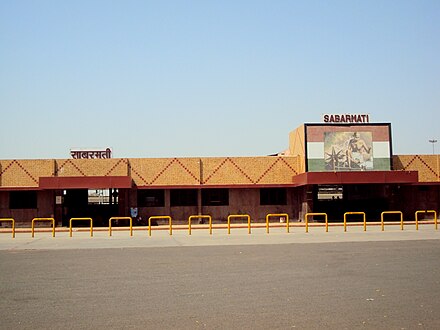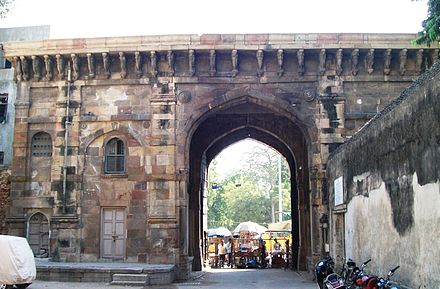Ahmedabad - city in the state of Gujarat, India

Ahmedabad (Gujarati: અમદાવાદ Amdāvād, Hindi: अहमदाबाद Ahmadābād) is the fifth largest city in India with a population of 6.5 million. Although it is the commercial hub of one of the most prosperous states of India, Gujarat, it's not the state capital, which is its twin city of Gandhinagar, 30 km to the north.
Ahmedabad is a good example of contrast between the materialistic attitude and the spirituality of self-renunciation. One of the fastest growing cities in India, Ahmedabad is a centre for information technology, education and industries. Bhadra Fort, Shaking Minarets and Tran Darwaja are the foremost historical sites of the city. Kankaria Lake and Vastrapur Lake are places which let you feel the pleasure of nature. If you want to enjoy the colourful side of this area, then pay a visit during the major festivals of Ahmedabad: Uttarayan and Navratri are two festivals that are celebrated with great zeal and gusto. Winter is considered the best time to visit the city.
Districts
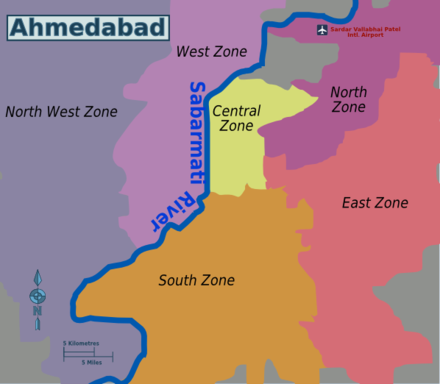 The classification below is according to Ahmedabad Municipal Corporation (AMC). The West Zone and New West Zone are on the west side of the Sabarmati River while all other zones are on the east side.
The classification below is according to Ahmedabad Municipal Corporation (AMC). The West Zone and New West Zone are on the west side of the Sabarmati River while all other zones are on the east side.
Central Zone (Girdharnagar, Madhupura, Dudheshvar, Shahpur, Dariapur, Kalupur, Raikhad, Jamalpur, Khadia)
This zone mostly consists of the Walled City areas of Ahmedabad and the famous Mughal architecture of the old times. The main Ahmedabad Railway Station (ADI) is in Kalupur.
North Zone (Sardarnagar, Nobalnagar, Naroda, Kubernagar, Meghaninagar, Asarva, Shahibaug, Naroda Road, Thakkarbapanagar, Saraspur, Nava Naroda)
SVP International Airport (AMD) is in Hansol. Asarva is well known for the Ahmedabad Civil Hospital and Naroda is the industrial area now developing rapidly.
South Zone (Behrampura, Kankariya, Indrapuri, Khokhra, Maninagar, Narol, Danilimda, Lambha, Isanpur, Ghodasar, Vatva)
Kankariya Lake is a very popular and relaxing place here. Maninagar Railway Station serves this region of the city, as an alternative station to the main railway station in Kalupur in Central Zone. The prestigious Ahmedabad - Vadodara National Expressway - 1 starts from the C.T.M.
East Zone (Nikol, Bapunagar, Gomtipur, Rakhial, Odhav, Vastral, Hatkeshwar, Ramol, Hathijan)
Mostly industrial areas.
West Zone (Motera, Chandkheda, Sabarmati, Vadaj, Usmanpura, Navrangpura, Ambawadi, Paldi, Vasna)
Motera, Chandkheda and Vasna are rapidly developing suburbs. Motera-Chandkheda, in Northern portion, serve as exits to the capital and twin city of Gandhinagar via Visat-Gandhinagar Intercity Highway (up to Infocity Gandhinagar). Sabarmati is one of the oldest areas of Ahmedabad, having the Sabarmati Railway Station (SBI) for North India-bound trains (as an alternative station to the main railway station (ADI) in Kalupur in Central Zone). Ashram Road and C G Road are core business and commercial areas. Vasna is quite in Southern portion and is an industrial area.
New West Zone (Gota, Chandlodiya, Kali, Ranip, Thaltej, Bodakdev, Sarkhej, Vastrapur, Vejalpur, Juhapura, Memnagar, Jodhpur Gaam)
Most of them are developing suburbs. IIM-Ahmedabad, one of the best business schools in India, is in Vastrapur. Vastrapur Lake is newly built artificial lake. Ranip is close to Sabarmati and has the Sabarmati Railway Station (SBT) for trains to/from Central India (as an alternative station to the main railway station (ADI) in Kalupur in Central Zone). Bodakdev and Vastrapur are well-known for commercial centres. Sarkhej is the Ahmedabad end of SG Highway that connects to Gandhinagar on the Western side.
Understand

History
The city was founded by King Karandev (Karna) in the 11th century and originally called "Karnavati". The Hindu kingdom of Karnavati retained its importance until 1411 when Sultan Ahmed Shah conquered Gujarat and created a new city nearby, naming it Ahmedabad, after himself.
The city was built in an open and spacious plain to the east of the Sabarmati River. It included a smaller known fort as Bhadra Fort. The city wall had twelve gates. The city gradually expanded in every direction, with well laid out beautiful buildings, lakes and mosques on both sides of the river.
In 1753 the combined armies of Raghunath Rao and Damaji Gaekwad took the fort, ending Mughal rule in Ahmedabad. During the 64 years of rule by Gaekwad and Peshwa, the city became cleaner. In 1818 the British annexed Ahmedabad. During this period the municipality committee was founded and a railway link was established.
The British restricted themselves to the cantonment area and didn't take much interest in the city. Nor did they get around to colonising Ahmedabad culturally; they didn't set up schools, churches and clubs all over the city as they did in other cities they integrated to their way of life.
Ahmedabad was a cradle of the non-violent movement for India's independence, being host to the Sabarmati ashram of Mahatma Gandhi. Ahmedabad poses a mixture of rich tradition and modern feel.
Today
The Gujarati community is known for its hospitality and for being shrewd businessmen. Ahmedabad is a big industrial city long reputed for its textile industry, and today more so for its chemical, petroleum, international trade & IT industries. It is also known for its financial services industry, and as the modern hub of the Jain Religion. The city has institutions such as the Indian Institute of Management - Ahmedabad, National Institute of Design, Pandit Deendayal Petroleum University (PDPU), Dhirubhai Ambani Institute of Information & Communication Technology, IHM, MICA, EDI, Nirma University, Swaminarayan Gurukul, CEPT (Centre for Environmental Planning and Technology) University and NIFT.
Climate
Summer starts by mid-March and lasts up to mid-June. The typical temperature on a hot, sunny day in May would be 34-44°C (93-111°F) It's advisable not to visit during the summer. With the arrival of the monsoon by mid-June, the city becomes a fun place. You'll be able to enjoy the various monsoon specialities of the city like boiled or roasted corn dishes on road-side stalls or some special local dishes like. There are also some famous Hindu festivals like Rakshabandhan (or Rakhi) and Janmastam, the birth date of Lord Krishna, which fall during this season. You may sometimes end up in floods. Winter is the best season to visit the city when the typical temperature is 5-20°C (41-68°F).
Get in
By plane

- Sardar Vallabhbhai Patel International Airport (IATA: AMD), 23.073693°, 72.626582°. The airport is expanding with permissions for many international air lines being given and development of new terminals.

International flight connections include Muscat, London Heathrow (Air India), Kuwait (Kuwait Airways), Dubai (Emirates), Doha (Qatar Airways), Sharjah (Air Arabia) and Singapore (Singapore Airlines).
Domestic destinations with daily flights include Mumbai, Delhi, Indore, Chennai, Bangalore, Goa, Kolkata, Jaipur, Pune, Coimbatore, Hyderabad, Nagpur, Kandla and Surat. Most domestic airlines have a flight in and out of Ahmedabad.
Passengers arriving in the morning are advised that the international terminal is not open 24 hours, and may not open until the late afternoon. As at other Indian airports, you will likely be denied entry until approximately three hours before your scheduled flight even if the terminal is open. Therefore, connecting between a domestic and an international flight will often involve waiting outside for hours with the throngs of touts and hustlers.
There are several options for getting from the airport to the city:
- By car: The Hansol area where the airport is lies near the river banks, between the areas of Shahibaug and Naroda that give access to Ahmedabad. For travelling to most of the main areas of Ahmedabad, head in the direction of Shahibaug. To the opposite of the river banks is the area of Motera - Chandkheda which are the northern ends of Ahmedabad and are better accessible through Koteshwar - Bhat Road (enters Motera through Koteshwar) or Ring Road (leading to Visat, turning left at Tapovan Circle); both these roads branch at different points on the road from Airport Circle (in direction of Naroda from the airport) to Koba Circle (take left from Airport Circle onto Indira Bridge). Also the SG Highway can be accessed by heading straight on the Ring Road, instead of turning left for Visat.
- An auto rickshaw or a taxi should cost roughly ₹ 200 or 300 respectively. Save yourself considerable hassle by using the prepaid booth, or preferably arrange a pickup in advance with your hotel.
- AMTS buses serve the airport directly. These buses have an extensive network all over the city.
- BRTS bus no 1000 runs between the airport and Karnavati club with 29 stops. The maximum fare is ₹50. The buses have AC and arrive every 30 minutes.
By train

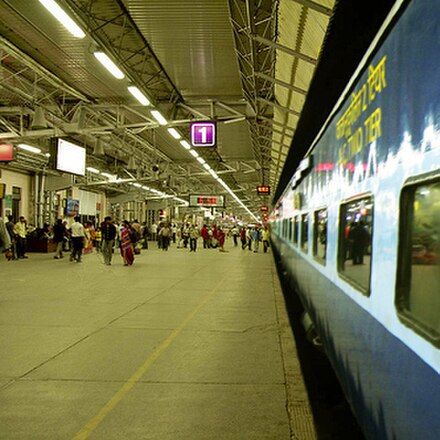 Indian Railways has a very wide network all over India and Ahmedabad (Central) Railway Station (Station code: ADI) is connected with Mumbai (500 km), Vadodara Jaipur, Jodhpur and Delhi with trains several times a day. Daily connections (or multiple weekly connections) are also available to several other major cities including Bikaner, Rajkot, Surat, Vadodara, Udaipur, Indore, Pune, Bhopal, Kolkata, Nagpur, Lucknow, Varanasi, Bhubaneswar, Puri, Chennai, Nagarcoil, Trivendram, Bangaluru, and Coimbatore. Direct trains are also available for Jammu, Patna, Darbhanga, Muzaffarpur, Kolhapur, Goa, Mangalore, Cochin, Trivandrum, Hyderabad and Bangalore.
Indian Railways has a very wide network all over India and Ahmedabad (Central) Railway Station (Station code: ADI) is connected with Mumbai (500 km), Vadodara Jaipur, Jodhpur and Delhi with trains several times a day. Daily connections (or multiple weekly connections) are also available to several other major cities including Bikaner, Rajkot, Surat, Vadodara, Udaipur, Indore, Pune, Bhopal, Kolkata, Nagpur, Lucknow, Varanasi, Bhubaneswar, Puri, Chennai, Nagarcoil, Trivendram, Bangaluru, and Coimbatore. Direct trains are also available for Jammu, Patna, Darbhanga, Muzaffarpur, Kolhapur, Goa, Mangalore, Cochin, Trivandrum, Hyderabad and Bangalore.
Ahmedabad Central Railway Station (Kalupur Railway Station), 23.025504°, 72.601430°. (Station code: ADI), the main railway station serving the city is in Kalupur (Central Zone). The other stations serving Ahmedabad are Maninagar, Vatva, Gandhigram, Asarva, Chandlodia, Chandkheda, Saij, Kalol Jn, Kali Gam, Vastrapur, Sabarmati, Sarkhej, Naroda, Gandhinagar, Khodiyar, Aamli. Although the important and well-connected ones are only Sabarmati Junction (for West & South-bound trains (Ranip), 23.071845°, 72.587134°. Station code: SBI, for North-bound trains (Dharmnagar), 23.076406°, 72.588787°. Station code: SBT) in the neighbourhood of Sabarmati (Northern West Zone) and Maninagar Railway Station, 22.998730°, 72.611512°. (Station code: MAN) in Maninagar (South Zone).
The website of Indian Railways will show you trains from a particular station to your destination along with days, timings, fares and availability. This will help you find trains from individual stations of Ahmedabad (separate searches) as NOT all trains stop at all stations except of course, the main Ahmedabad Railway Station (Station code: ADI) where each train halts (and for longer durations than any other station). Booking can be done through the website of IRCTC, a subsidiary of Indian Railways or through any of the railway reservation centres throughout India.
From railway stations to city
Ahmedabad Railway Station
It is in the area of Kalupur (Central Zone). It has a road-side Janmarg BRTS stand within the campus of the railway station, which is just outside the main entrance of the railway station. It is directly served by BRTS buses on the Line no. 9 (towards RTO Circle [Northern West Zone] and towards Ellisbridge [Central West Zone]) and Line no. 10 (towards Vasna [Southern West Zone]) and AMTS also directly serves the station to various parts of the city.
Sabarmati Junction
It is in the neighbourhood of Sabarmati (Northern West Zone), is served by BRTS buses through the BRTS stations of either Sabarmati Powerhouse (closer to the railway station) or Sabarmati Police station, both on Line no. 8 (towards Maninagar (South Zone) and towards Visat Junction (serving the suburb of Chandkheda)). It is also served by AMTS buses directly.
Maninagar Railway Station
It is in Maninagar (South Ahmedabad) is directly served by BRTS buses on the Line no. 1 (towards RTO Circle [Northern West Zone]), Line no. 5 (towards Iskcon New West Zone) and Line no. 8 (towards Visat Junction [Northern West Zone]). AMTS buses also serve the railway station.
By state bus
Gujarat State Road Transport Corporation (GSRTC) has buses from all the parts of the Gujarat state entering into the city. The central bus terminus at Geeta Mandir, with other terminals at Subhash Bridge and Naroda; minor stops include Paldi and Sabarmati Tollnaka. It is advisable to pre-book seats due to the likelihood of crowding.
From bus terminals/stops to city
GSRTC Central Bus Terminus 📍 (Central Zone) is served by BRTS buses through the Aastodia Darwaja station on Line 9 (towards RTO Circle <nowiki>[</nowiki>West Zone<nowiki>]</nowiki> and towards Ellisbridge <nowiki>[</nowiki>West Zone<nowiki>]</nowiki>) and AMTS buses serve through the stop of Astodia Darwaja.
The GSRTC stop of Sabarmati Tollnaka 📍 is accessible through the BRTS station of Sabarmati Police station, both on Line 8 (towards Maninagar <nowiki>[</nowiki>South Zone<nowiki>]</nowiki> and towards Visat Junction [serving the suburb of Chandkheda]). AMTS buses also have a stop nearby.
By car
From South Gujarat/Maharashtra
 Driving to Ahmedabad from Mumbai on the new highway (NH-8) takes around 8 hours (without traffic) to travel 550 km. You'll pass Vapi, Valsad, Surat, Bharuch, Vadodara, Anand, and Nadiad on your way. Driving on the NH-8 is an energy sapper and no fun as there is a huge amount of truck traffic. Broken down trucks on the highway regularly cause traffic jams for hours on end. The journey from Vadodara to Ahmedabad can also be done via the dedicated express way (NE-1) which does not pass through any towns, rather than NH-8.
Driving to Ahmedabad from Mumbai on the new highway (NH-8) takes around 8 hours (without traffic) to travel 550 km. You'll pass Vapi, Valsad, Surat, Bharuch, Vadodara, Anand, and Nadiad on your way. Driving on the NH-8 is an energy sapper and no fun as there is a huge amount of truck traffic. Broken down trucks on the highway regularly cause traffic jams for hours on end. The journey from Vadodara to Ahmedabad can also be done via the dedicated express way (NE-1) which does not pass through any towns, rather than NH-8.
The expressway from Vadodara (South Gujarat) to Ahmedabad ends at C.T.M. (South Zone).
Via East
Turning right at C.T.M. is the Narol - Naroda Road leading you to Naroda in North East Ahmedabad, while passing through the areas of Vastral, Odhav, Nikol, etc. on the right side of the road and the areas of Maninagar, Shastri Nagar, Hansol (Airport Area) on the left side of the road. For the northern areas of Sabarmati, Motera, Chandkheda, etc.rcle, where the Narol - Naroda Road ends, head straight on NH-8 and turn left at Ranasan Circle onto Ring Road. Turn left at Tapovan Circle, after a few km, Motera will be on the left side of the highway, Chandkheda on the right. The highway ends at Visat, from where turning left will lead you to Sabarmati.
Via West
Turning left at C.T.M. is the Narol - Sarkhej Road which passes through Nehrunagar, Narol, Vatwa, Ghodasar, etc. ending at a T-junction on Vasna Road (or Jawaharlal Nehru Road). From here turn left, pass through the areas of Juhapura, Makarba, etc. till a Y-junction arrives. The right arm will lead you to Sarkhej Cross Roads, from where you turn right onto the S G Highway. The left arm at the Y-junction will lead you via Sarkhej, at Santhal Circle, turn right onto the Ring Road.
Ring Road is preferable if your destination is far (near Northern Ahmedabad) otherwise use S G Highway. Also for Bopal, use only Ring Road.
The major entry points from S G Highway are the areas of Prahladnagar, Shilaj, Vastrapur, Satellite, Bodakdev, Thaltej, Sola, Ognaj, Gota, etc.
From Gandhinagar/North Gujarat/Rajasthan
.png/440px-National_Highway_8_(India).png)
Via North and East
You can enter Ahmedabad by passing through Gandhinagar. The inter - city highway starts at Indroda Circle (CH 0) (South Gandhinagar), passing through Koba Circle and Tapovan Circle and ends at Visat (Northern West Zone), the junction to the suburbs of Sabarmati, Motera and Chandkheda. Rather than going to Visat, you can also choose to join Ring Road: From Koba Circle head on the road to Sardar Vallabhbhai Patel (SVP) International Airport, but turn left at Rajasthan Hospital Circle and you're on Ring Road. From here you can connect to the areas of East Ahmedabad such as Nikol, Odhav, Vastral, etc. Also the Southern areas of Ahmedabad, such as Ramol, CTM, Ahmedabad - Vadodara Expressway, Narol, Vatwa, etc. are accessible through Ring Road.
Via West
Another option is to bypass Gandhinagar using Mahatma Mandir Road, then turning right at Sargasan Circle onto S G Highway. You may stay on the S G Highway or turn right at SGVP Circle (also known as Vaishnodevi Circle) onto Ring Road. There are several entry points along the border of extreme Western Ahmedabad, such as Gota, Ognaj, Sola, Thaltej, Bodakdev, Satellite, Vastrapur, Shilaj, Bopal, Prahladnagar, Sarkhej (where S G Highway ends) and Juhapura. For getting to Bopal, use Ring Road rather than S G Highway. Also if you've to go to Southern Ahmedabad, choose Ring Road as it'll be a much faster option than S G Highway.
Get around
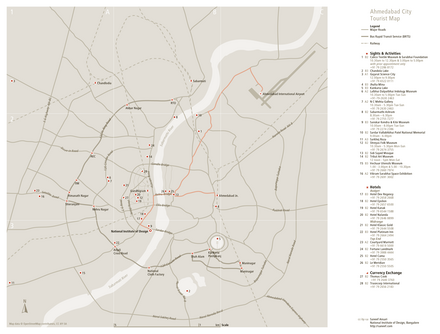 The services of AMTS and BRTS run from 6AM to 11PM.
The services of AMTS and BRTS run from 6AM to 11PM.
By AMTS city bus
The local city buses are run by Ahmedabad Municipal Transport Service (AMTS). since 1947, forming a wide network covering almost all the points of Ahmedabad. Any destination in the city can be reached from anywhere in the city by AMTS.UTTAR PRADESH

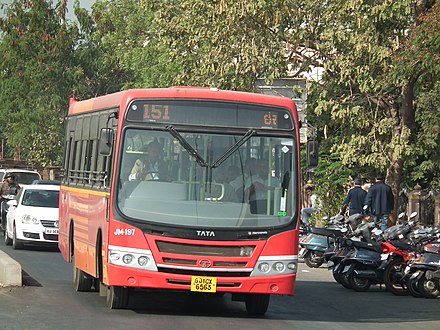 To identify them and distinguish them from the state transport GSRTC buses or the private luxury buses here is the key: The older buses in this service are painted in red and white or in red and yellow, whereas new bright red ones put up under JnNURM are having electronic display boards. You may easily ask around the people esp. those waiting at one of the AMTS stops about the route, time, etc. as the information displayed is in Gujarati. Also, Public Transit option on Google Maps will show you the nearest AMTS stop while searching directions from your location to the destination and it also gives information about the bus numbers, transfer points, etc. though timings might not be reliable. Also you may install an unofficial app named 'Ahmedabad AMTS Info', available on Google Play Store for Android devices, which guides you regarding travel routes, transfers, etc.
To identify them and distinguish them from the state transport GSRTC buses or the private luxury buses here is the key: The older buses in this service are painted in red and white or in red and yellow, whereas new bright red ones put up under JnNURM are having electronic display boards. You may easily ask around the people esp. those waiting at one of the AMTS stops about the route, time, etc. as the information displayed is in Gujarati. Also, Public Transit option on Google Maps will show you the nearest AMTS stop while searching directions from your location to the destination and it also gives information about the bus numbers, transfer points, etc. though timings might not be reliable. Also you may install an unofficial app named 'Ahmedabad AMTS Info', available on Google Play Store for Android devices, which guides you regarding travel routes, transfers, etc.
AMTS Central Bus Terminus (Lal Darwaja), 23.024944°, 72.578251°.
There are other terminals at Kalupur, Sarangpur, Old Vadaj (Juna Vadaj), Maninagar, Akhbarnagar (Nava Vadaj), Vasna and Naroda and the depots at Jamalpur, Memco (Naroda Patiya) and Memnagar. In total, AMTS has around 1200 stops with 210 routes.
It is mandatory to board the bus from the rear end door and alight from the front end one. The conductor on the bus will issue you a ticket according to your destination stop. Keep handy some notes of ₹ 10/20/50 denominations rather than the higher ones as the fares are very low (these buses are the cheapest means to travel in the city). A pay - per - ride fare will cost you a minimum fare of ₹ 3, while the maximum fare is only ₹ 25). You may also opt to buy a Man Pasand ticket worth ₹ 45 (available from the bus conductor) which entitles you to unlimited rides for a single day, though it is not preferable to purchase the ₹ 45 ticket as you can complete the journey of going around 4-5 places in just ₹ 30–35. As buses are the most common transport facility for many in the city they are often overcrowded.
During the journey you may request your co-passengers or the conductor to inform you when the destination arrives/is about to arrive so that you don't miss getting off at your stop and then have to take a reverse trip. Also keep moving towards the front end door as the bus will be crowded with people standing in the corridor between seats and it might be difficult to quickly rush to the door and get off, when your destination arrives (the bus won't halt at a stop more than 10-12 sec, unless it's the AMTS Central Terminus at Lal Darwaja or the last stop of the journey).
Routes can be found at AMTS bus routes (English) (dead link: March 2023)
Heritage/Pilgrim Tours (Dekho Amdavad)
AMTS has a special programme Dekho Amdavad, i.e. See Ahmedabad for sight-seeing in Ahmedabad. The buses are air-conditioned. The starting point is Law Garden Civic Centre. +18002337951, +917926589172
- Morning Tour: 7:45AM start at Law Garden Civic Centre, visiting Siddi Saiyyed Mosque (Jali), passing through Jhulta Minara (Shaking Minarets), Prem Darwaja (Love Gate), Delhi Darwaja (Delhi Gate), visiting Hutheesingh Jain Temple, Sardar Patel Memorial, Gandhi Ashram-Museum and returning at 1PM.
- Afternoon Tour: 1:45PM start at Law Garden Civic Centre, passing through IIM, Ring Road, APMC, visiting Sarkhej Roza, Vaishnodevi, Adalaj Stepwell, Gandhi Ashram-Museum, Hutheesingh Jain Temple, passing through Prem Darwaja (Love Gate), Jhulta Minara (Shaking Minarets), visiting Kankaria Lake and returning at 8:15PM.
- Sunday Special Pilgrim Tour: 8AM to 8PM. Visits at Jalaram Temple (Paldi), Bhadrakali Temple (Bhadra/Lal Darwaja), Siddhivinayak Temple (Lal Darwaja), Jagannath Temple (Jamalpur), Hutheesingh Jain Temple (Shahibaug), Swaminarayan Temple (Shahibaug), Gayatri Temple (Shahibaug), Camp Hanuman Temple (Shahibaug), Dholeshwar Mahadev Temple (Gandhinagar), Akshardham Temple (Gandhinagar), Trimandir (Adalaj), Vaishnodevi Temple (S G Highway), Balaji Temple (SG Highway), Bhagwat Vidyapeeth (Gota), ISKCON Temple (S G Highway).
By BRTS city bus
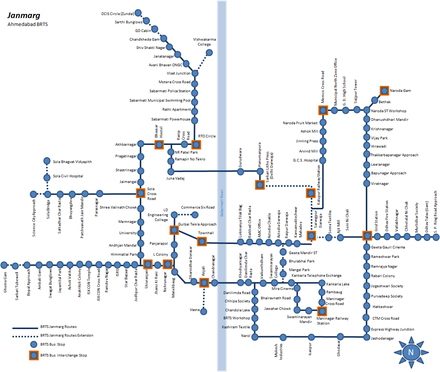

 Ahmedabad BRTS. (bus rapid transit system) has silver and blue-coloured buses running on dedicated corridors in the centre of the roads. BRTS does not cover the entire city, but wherever available it is the best way to commute as it is remarkably faster than other modes (as no other vehicle can ply on BRTS corridor) and all the stations are marked well, in both English and Hindi. One can also travel using a combination of BRTS, AMTS and/or auto rickshaw. The ticket systems of BRTS and AMTS are not integrated. The fares are only slightly higher than AMTS (min. fare ₹ 4, max. fare ₹ 36)
Ahmedabad BRTS. (bus rapid transit system) has silver and blue-coloured buses running on dedicated corridors in the centre of the roads. BRTS does not cover the entire city, but wherever available it is the best way to commute as it is remarkably faster than other modes (as no other vehicle can ply on BRTS corridor) and all the stations are marked well, in both English and Hindi. One can also travel using a combination of BRTS, AMTS and/or auto rickshaw. The ticket systems of BRTS and AMTS are not integrated. The fares are only slightly higher than AMTS (min. fare ₹ 4, max. fare ₹ 36)
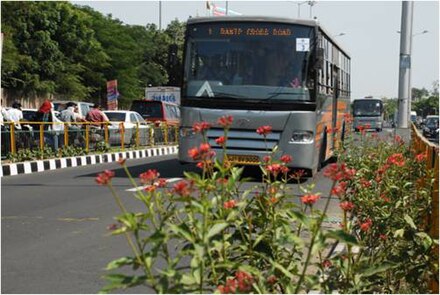 The BRTS stations are elevated shelters in the dedicated central corridor of the city roads, from where you can purchase your ticket. Keep the ticket with you until you get off at your destination, where you show the ticket to the checker and then leave the station on to the road. Buses are equipped with central automatic doors that open up automatically when the bus halts at a station. While the bus is about to arrive at a station, there are announcements with name of the station along with display on the electronic board inside the bus. Inside the stations, there are boards displaying real-time information about arrivals or upcoming buses, along with the routes and estimated time remaining for the arrivals. The name of the station will be printed in white letters on blue strips on the sides (horizontal) and on the roof of the station (vertical).
The BRTS stations are elevated shelters in the dedicated central corridor of the city roads, from where you can purchase your ticket. Keep the ticket with you until you get off at your destination, where you show the ticket to the checker and then leave the station on to the road. Buses are equipped with central automatic doors that open up automatically when the bus halts at a station. While the bus is about to arrive at a station, there are announcements with name of the station along with display on the electronic board inside the bus. Inside the stations, there are boards displaying real-time information about arrivals or upcoming buses, along with the routes and estimated time remaining for the arrivals. The name of the station will be printed in white letters on blue strips on the sides (horizontal) and on the roof of the station (vertical).
All BRTS buses and stations are wheelchair accessible except those of RTO Circle and Kalupur Railway Station, which are roadside shelters unlike the standard BRTS stations.
For information on all the BRTS stations, visit the above-linked website, which shows them according to the line, or install an unofficial Android app, which provides information such as travel options, routes, fare, time, station names, etc. (NThe Public Transit option on Google Maps doesn't show BRTS services, only the AMTS ones)
There are 12 BRTS lines and 126 stations, with more under construction. The current lines are:
- Line 1 RTO Circle - Maninagar
- Line 2 Anjali (Vasna) - Naroda
- Line 3 RTO Circle - Naroda
- Line 4 RTO Circle - Sarkari Litho Press (Delhi Darwaja)
- Line 5 Bopal - Iskcon - Maninagar
- Line 6 Soni Ni Chali - Odhav - S P Ring Road
- Line 7 Sarkari Litho Press (Delhi Darwaja) - Science City Approach
- Line 8 Chandkheda - Visat Junction - Maninagar
- Line 9 RTO Circle - Town Hall (Ellisbridge)
- Line 10 Anjali (Vasna) - Kalupur Railway Station (Ahmedabad Central)
- Line 12 RTO Circle - Nehrunagar - Kalupur - RTO Circle
- Line 13 Anjali (Vasna) - Kalupur - Akhbarnagar - Anjali (Vasna)
By metro
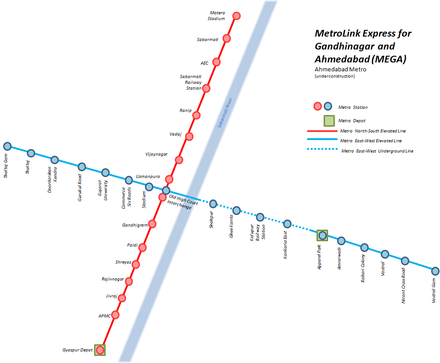 Ahmedabad Metro. Metro is probably the most convenient way to get around the areas it serves. It operates on north-south and east-west corridors. Ticket of Rs.5 upto ride of 2.5km, Rs. 10 from 2.5 to 7.5km, Rs.15 from 7.5 km to 12.5 km, Rs. 20 from 12.5km to 17.5km, Rs. 25 from 17.5 to 22.5km.
Ahmedabad Metro. Metro is probably the most convenient way to get around the areas it serves. It operates on north-south and east-west corridors. Ticket of Rs.5 upto ride of 2.5km, Rs. 10 from 2.5 to 7.5km, Rs.15 from 7.5 km to 12.5 km, Rs. 20 from 12.5km to 17.5km, Rs. 25 from 17.5 to 22.5km.
By auto rickshaw
 These yellow and green three-wheeled noise machines, known as auto-rickshaws or simply rickshaws, are always cheaper than taxis, and much costlier than AMTS or BRTS when distance is longer than 3 km. They are not very comfortable and spacious. The drivers might ride very roughly, in which case you might request him to drive smoothly and slowly.
These yellow and green three-wheeled noise machines, known as auto-rickshaws or simply rickshaws, are always cheaper than taxis, and much costlier than AMTS or BRTS when distance is longer than 3 km. They are not very comfortable and spacious. The drivers might ride very roughly, in which case you might request him to drive smoothly and slowly.
Shouting 'auto' or 'rickshaw' at a passing rickshaw should be enough to catch the drivers attention. In most cases, the drivers will be able to understand Hindi and maybe even a few words of English. They are normally quite helpful, but some will try to cheat tourists. As always, agree on a fare before getting in. Day and night fares are different. If you look an out-of-the-town person, you may end up getting overcharged. For example, he might insist on a fare based on meter and take you to your destination through a longer route. Having some understanding about the distances can be helpful.
By taxi
Since auto rickshaws are the dominant travel mode apart from BRTS and AMTS, there are few taxis in Ahmedabad. So you will hardly find a taxi on the roads to hail whenever needed, though you may either book a taxi from a hotel or directly book one outside the railway station. There is a government authorized taxi stand. ₹ 950 per day for 12 hours. It may be more costly to book through hotels, and it is better to negotiate with the driver directly. Online bookings are also possible at various websites.
Talk
The local language is Gujarati. Hindi is understood by almost everyone and English understood by well-educated people and most people in the tourism industry.
See
Ahmedabad has several floridly carved historic monuments including the Stepwell at Adalaj and the Rani Mosques (dedicated to Rani Sipri and Rani Rupmati). There are some museums and art galleries. Modern office buildings and malls dot the more recently developed areas.
Important places to see include:

- Gandhi Aashram (Sabarmati Ashram), Gandhi Ashram, Gandhi Smarak Sangrahalaya, Ashram Road, 23.06°, 72.580833°, +91 79 27557277, admin@gandhiashramsabarmati.org. 8AM-7PM. The Sabarmati Aashram was once the house of Mahatma Gandhi and he founded the ashram in 1915. Today, without doubt, it is the biggest visitor attraction in Ahmedabad. It lies on the tranquil stretch of the Sabarmati river and was referred to as the Satyagraha Ashram during the lifetime of the Mahatma. It was from here that the Mahatma began his famous 'Dandi March' in 1930 to protest against the Salt Tax imposed by the British. One can see the three wise monkeys and many more of Gandhiji's teachings at the ashram premises. The ashram today continues the work started by the Mahatma and houses a handicrafts centre, a handmade paper factory and a spinning wheel factory. There are several other attractions.
- Bhadra Fort, 23.023611°, 72.581111°. To add special charm to the varied sights of the city there is the Bhadra Fort, which once housed royal palaces and well-laid gardens. It boasts the temple of Bhadrakali and was built in 1411 during the Maratha rule. As of early 2023, it's closed for long term maintenance/building works.
- Calico Museum of Textiles, Sarabhai Foundation, Opposite Shahibagh Underbridge, 23.054409°, 72.592137°, +91 79 22868172. Th-Tu 10:30AM-12:30PM, 2:30-5:30PM. Has a magnificent collection of rare textiles dating back to the 17th century. There is also an excellent reference library on textiles. It's in the Sarabhai Foundation, in Shahibagh the Calico Museum of Textiles, widely regarded as one of the finest textile museums in the world was constructed in 1949. It has a fines collection of textiles, clothes, furniture, temple artefacts and crafts. Also has a collection of marble, sandstone and bronze icons.
- Dada Harir ni Vav, Asarva, 23.0407°, 72.605442°. A stepwell.
- Darpana Academy of Performing Arts, 23.047774°, 72.572794°. One of the oldest performing arts academies in the city. Its amphitheatre Natarani has a fabulous performance venue overlooking the Sabarmati river, and is one of the few places to bring internationally acclaimed performing artists to the city.
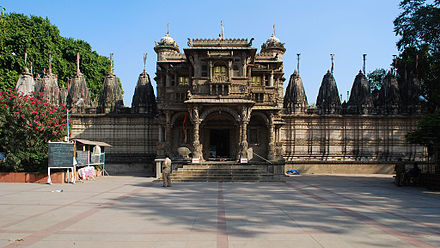
- Hutheesing Jain Temple, Shahibaugh Road, Madhupura, 23.041088°, 72.589611°. An impressive white structure, the Jain temple built of white marble and elaborately carved is dedicated to Dharmanath: the 15th Jina or Jain Apostle. Similar to all Jain temples, this temple to is rich in intricate carvings displaying, among other things, musicians.

- Heritage Houses of poles, A living heritage, the structures are 200–400 years old and the residents people are old Ahmedabadi families who still follow age old traditions. Souvenir shop offering local crafts. Has an old world in a large house which is like a palace.
- Indian Institute of Management (IIM-A), IIM Ahmedabad, Vastrapur (Accessible easily from Andhjan Mandal/IIM BRTS bus station, near IIM Cross Roads on Inner Ring Road), 23.030646°, 72.535991°. A Business School of Management housed in an architecturally impressive building.
- International Society for Krishna Consciousness Temple (ISKCON Temple), ISKCON, Satellite Road, Sarkhej-Gandhinagar Highway Crossing (Accessible easily by BRTS bus station and AMTS bus stop named 'ISKCON Temple' or 'ISKCON Cross Roads'), 23.028609°, 72.506719°, +91 79 26861945, iskcon.ahmedabad@pamho.net. 4:30AM-1PM, 4-9PM. This Hindu temple depicts Krishna, and his lover, Radha, who is regarded as the personification of love.
- Auto World Vintage Car Museum, Dastan Estate, Eastern Sardar Patel AUDA Ring Road, Kathwada (The Ring Road encircles the city of Ahmedabad, get onto the eastern part of it), 23.057177°, 72.684831°, +91 79 22820699, dasco@vsnl.com. Shri Pranlal Bhogilal has a converted his private collection of vintage cars into a museum. It has a collection of more than 100 cars including Rolls Royce, Bentley, Maybach, Jaguar, Cadillacs, Austin, Chrysler, Lincoln, Ford and many many more. You can drive some of them for ₹500 for 3.5 km.
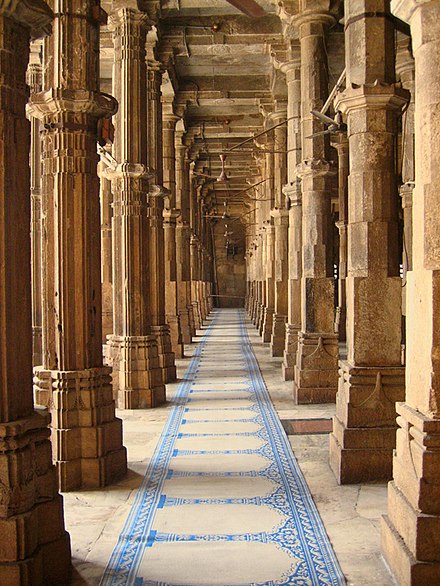
- Jama Masjid (Jama Mosque), Jama Masjid, Manek Chowk, Gandhi Road, Khadia, 23.023822°, 72.587222°. It is amongst the most popular tourist sights in the city. Built of yellow sandstone this mosque stands on 260 pillars which support 15 domes at varying elevations. The mosque was built by Ahmad Shah in 1423. It is easily accessible as it stands in the centre of the old city. This imposing structure reflects the Muslim architecture of that period.
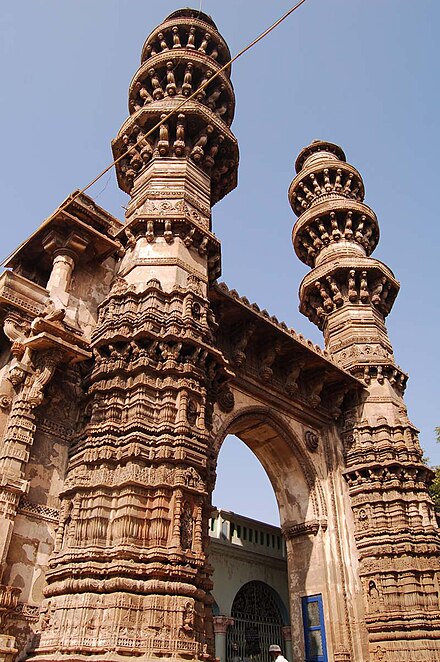
- Jhulta Minara (Shaking Minarets), 23.0277°, 72.6012°. Quite an unusual structure, Jhulta Minara or swaying minarets are a part of the mosque of Siddi Bashir and can be moved back and forth by applying a little force at the topmost arch. One of the minarets was partly demolished by an Englishman in his endeavours to unravel the mystery of the swaying minarets. The mosque was built by master craftsmen and the crucial mechanism that leads to the vibration is still a mystery.
- Kankaria Lake, Kankaria Lake, Kankaria (Accessible easily by BRTS bus station 'Kankaria Lake' and AMTS bus stop of the same name), 23.006355°, 72.602541°. Tu-Su. A circular lake built in 1451 by Sultan Qutub-ud-Din. In the centre of the lake is an island garden with a summer palace known as Nagina Wadi. It has a beautiful Musical Fountain show, although the music isn't too good the lights and fountain are worth the visit. 'Bal Vatika' - an aquarium, a boat club, a toy train, a natural history museum and a zoo. ₹10 entrance fee. ₹10
- Kamla Nehru Zoological Garden (Kankaria Zoo), Kankaria Zoo, Kankaria (Accessible easily by BRTS bus station 'Kankaria Lake' and AMTS bus stop of the same name), 23.009811°, 72.600501°, +91 79 25463415, +91 79 32984115, kankaria@ahmedabadzoo.in. Tu-Su 10AM-6PM. It is near to Kankaria Lake and one of the best zoos in India.
- Lalbhai Dalpatbhai Museum (L D Institute of Indology), Near Gujarat University, Navrangpura, 23.2°, 72.33°, +91 79 26302463. Lalbhai Dalpatbhai Institute of Indology was established in Ahmedabad by Muni Shri Punyavijayji and Shri Kasturbhai Lalbhai. The museum houses priceless collection of books, manuscripts and other reference material from ancient India.The museum is a treasure trove of manuscripts relating to Jainism. In all there are about 45,000 printed books with 75,000 manuscripts including out of which 500 are illustrated ones. These documents from the past cover a wide range of subjects like Vedas, Agamas, Buddhism, Tantras, Jain Darshana, System of Indian Philoshy, Jaina Philoshpy, Grammar and Poetics etc.The institute has also published seven volumes of catalogues in Hindi, Sanskrit, Old Gujrati, Prakrit and Rajasthani. The institute also conducts periodical workshops on manuscriptology and palaeography.
- Lalbhai Dalpatbhai Museum (L D Museum/N C Mehta Gallery), Lalbhai Dalpatbhai Museum, Nr. Gujarat University, Navarangpura (Accessible by 'L D Engineering College' BRTS bus station and 'St. Xavier's College' AMTS bus stop), 23.033708°, 72.550605°, +91 79 26306883, mail@ldmuseum.co.in. One of the best art museums in the city. It has a wide collection of Indian miniature paintings, stone sculptures, terracotta, paintings of Tagore, art of Nepal and Tibet, bronzes, textiles, wood work, cloth paintings, metal sculptures, coins.
- Law Garden, 23.026607°, 72.560773°. Considered the main centre of activity in Ahmedabad, one can purchase handicrafts and traditional Gujarati outfits, amongst other things
- National Institute of Design (NID Ahmedabad), National Institute of Design, Paldi (in Paldi in West Zone), 23.011111°, 72.569444°, +91 79 26629500, +91 79 26629600, info@nid.edu. A design institute with over 16 disciplines of design.
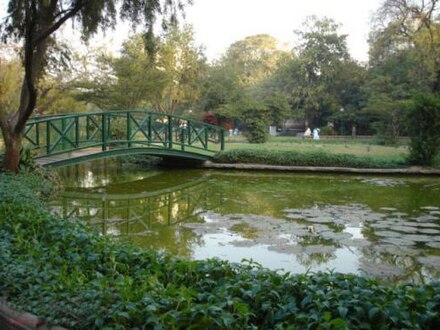
- Parimal Garden, C G Road, Panchavati Society, Gulbai Tekra, 23.020126°, 72.556343°. A public park with nice green surroundings. A good place to jog and relax.


- Sabarmati Riverfront, 23.034137°, 72.572326°. Across the city on both the banks of the Sabarmati River, is a refreshing place in the mornings; a very relaxing atmosphere in the evening. A must-visit place. It can be accessed by a narrow road on the right, a few metres ahead from the point where Subhash Bridge ends on the Shahibaug side. Also a road to the left, just a little ahead of Income Tax on Ashram Rd (from RTO side), leads to the Riverfront on the opposite bank to that of the Subhash Bridge one. Visit Atal Bridge, 23.01647°, 72.575446°. .
- Sardar Vallabhbhai Patel National Memorial, Balvantrai Mehta Road, Shahibagh, Ahmedabad - 380004 (accessible by 'Circuit House' AMTS bus stop, it's on the Airport Road), 23.061°, 72.591°. M-Sa 9AM-6PM. It is a memorial and museum dedicated to the National Activist and first Home Minister of independent India, Sardar Vallabhbhai Patel. The Museum is opposite the Circuit House in the Moti Shahi Mahal Complex in Shahibaug.
- Narendra Modi Cricket Stadium (Motera Stadium), Motera Stadium Road, Motera-Sabarmati (accessible by 'Sabarmati Police Station' & 'Motera Cross Road' BRTS station and 'Gujarat Stadium' AMTS bus stop), 23.091667°, 72.5975°. Narendra Modi Cricket Stadium is an international cricket stadium. Watching Team India play here is a wonderful sight as thousands of fans cheer for them. Rebuilt in 2020.
- Sarkhej Roza, Makarba, Post Jeevraj Park (accessible by S G Highway), 22.992136°, 72.504573°, +91 79 6828675, info@sarkhejroza.org. Known for its architectural complexes.
- Gujarat Science City, Gujarat Science City, Science City Road (accessible by Western Sardar Patel AUDA Ring Road, Sola Cross Roads on S G Highway. Accessible by 'Science City Approach' BRTS bus station and 'Science City' AMTS bus stop), 23.079852°, 72.494779°, +91 79 65220111, mail@scity.org. The Government of Gujarat has established the Gujarat Council of Science City, a registered society, to achieve the Gujarat Science City mandate. Further expansion of Science City & related projects is planned.
- Sidi Saiyyed Mosque, 23.026944°, 72.581111°. is unique for its exquisite screens. The screen carved out of one rock is exceptional.
- Swaminarayan Gurukul, a residential and day boarding school run by the Swaminarayan faith of Hinduism. It teaches not only formal education but also provides training in horse-riding, archery, dairy development.
- SG Highway, or Sarkhej - Gandhinagar Highway, a hub of entertainment in Ahmedabad. The same road leads to Gandhinagar as well, where there is Akshardham temple and other places of interest.
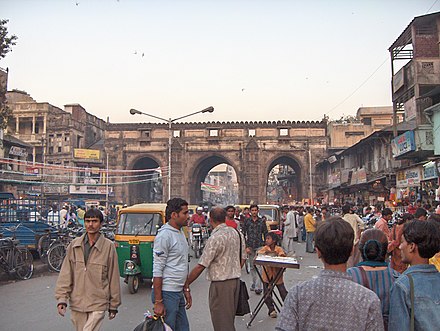
- Teen Darwaja (Three Gates), south of Shahpur near Lal Darwaja, 23.024203°, 72.584641°. It is composed of 3 arched entrances was built by Sultan Ahmed Shah to serve as a royal entrance to Maidan Shahi. Mughal emperor Jehangir and his wife Nur Jahan used to watch the Tazia procession of Mahuram from over these gates.
- Vaishnodevi Temple, replica of famous Vaishnodevi temple at Sola Gandhinagar Highway.
- Vastrapur Lake, 23.0384°, 72.529°. artificial lake.
- Veechar Utensil Museum, an odd museum with over 3,000 old, traditional household items. It is based on one man's personal collection. The lack of signs or explanation limits the understanding, and for many the interest, for visitors. The museum is a part of the Vishalla restaurant which serves ethnic Gujarati food.
_India.jpg/440px-Ancient_well_at_Adlaj_(Ahmadabad)_India.jpg)
Do
Itineraries
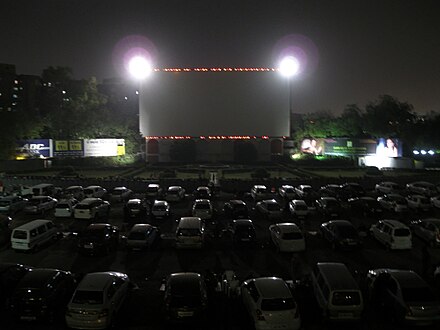
Films
Only some of the cinemas are listed here. For more, visit individual pages of different zones.
Watch a Gujarati film
- Gauri Cinema, Near Soni ni Chali, National Highway - 8, Odhav, +91 79 22872444.
- Ashok Cinema, Gheekanta Char Rasta, +91 79 25356598.
- Sapna Cinema, Sarkhej Highway (National Highway - 8A), Sarkhej, +91 79 26820750.
Watch a Bollywood (Hindi) or Hollywood film:
- Cinépolis, Cinepolis India Pvt. Ltd., 3rd floor, Alpha One Mall, Vastrapur. A Mexican cinema theatre chain, one of the best quality screens in Ahmedabad.
- Sunset Drive-In Cinema, Drive-In Road, +91 79 27454600, info@sunsetdriveincinema.com. Evening. The largest screen in Asia. One can watch film sitting in your car, on the grass or in the balcony seats. Cheaper than most.
- Mukta A2 Cinema, 4th floor, Gulmohar Mall, Ramdevnagar, Satellite, +91 79 30464500, parvez@muktaarts.com. A venture by film maker Subhash Ghai. The quality of viewing and the seats (esp. legroom) is among the best in Ahmedabad.
- PVR Cinemas (PVR Acropolis), PVR Cinemas, 2nd floor, Acropolis Mall, Thaltej Cross Roads, S G Highway. A premier cinema chain in India.
- Grand Cinemas (Cine Grand), Balaji Agora Mall, Nr. Tapovan Circle, SP Ring Road (Outer), Sughad (Near Motera), Ahmedabad - 382424, +91 79 65211889, assistantmanager.agora@cinegrand.com. Dubai - fame Grand Cinemas. Very good quality screens, on North - Western periphery of Ahmedabad in a high-end mall (Agora Mall).
Festivals

- __Diwali__is one of the popular festival in Ahmedabad, Gujarat. It's called the festival of light. People make many sweets and meet each other on this day. It is a festival of Lord Rama and belongs to Ramayana.
- Makar Sankranti or festival of kites or "Uttarayan", 14 January, in the festival of Makar Sankranti or festival of kites or "Utarayan". The festival marks the end of winter and return of the sun to northern hemisphere and hence is named "Uttar ayan". On this day, many in the city start the day with kite flying, and continue into night with the flying of lamps (Tukkal) attached to kites. The sky is dotted with colourful kites throughout the day.
- RakshaBandhan - A festival celebrated by sisters and brothers. The festival consists of a sister tying a rakhi on the brother's hand. They ask to be by their side forever and also save them from all the problems they might face in the future. The festival is generally celebrated in the month of August.
- Holi - Better known as festival of colours, where people apply colour on their beloved very well known as 'gulaal', which was ideally made of 'Kesuda' a flowering plant. But, now people use the powdered form. People gather at one place forgetting all their problems and have fun in this festival. It is also very well associated with myth or Holika - Phrlad & Hirnayakashyapu.
- Navratri (festival of nine nights), Navratri or the festival of nine nights is devoted to Goddess Shakti. The festival also has the famous folk dance of Gujarat "Garba". The festival continues for nine nights, everybody takes part into it with same emphasis. Each night starts with ceremonial "Aarti" and is followed by Garba until midnight. The Garba dance is carried out around the statue of Goddess Shakti. Garba is also played with Dandiyas in hand. During these nights, the city is beautifully decorated and nights become short.
- Eid-Ul-Fitr OR Ramdhan Eid is celebrated on the first day of Shaw'waal, at the completion of Ramadan. Shaw'waal is the 10th month of the Islamic calendar. The Eid-al-Fitr is a joyous day when Muslims express joy for the health, strength and the opportunities of life, which they believe Allah has given to them to fulfill their obligation of fasting and other good deeds during the month of Ramadan.
The Muslims of Ahmedeabad and surrounding villages come to Eidgah (a holy place to perform Eids' Namaz (prayer) and Shahi Jam-E-Masjid. The people decorate their homes, shops, buildings, greet each other etc.
Buy
 Ahmedabad is known for its textile industries including traditional hand embroidered and tie-dyed clothes. If you buy from the roadside shops, be prepared to haggle. It would not be advisable to try these without a local guide. The city's main market area is situated at Teen Darwaja, Dhalgarwad, Ratan Pole, Manek Chowk(old areas)near Lal Darwaja and newer markets such as CG Road and Sarkhej - Gandhinagar highway near Vastrapur & Gurukul. It is generally a crowded area, and very crowded during festival seasons, although with a wide variety of clothes. The street side shops near Law Garden also offers good choices. Some shops such as Bandhej and Sanskruti offer these traditional items at fixed (and maybe overpriced) rates. But now the big shopping malls are offering almost all the things at a very cheap rate. Local sweet shops, where traditional Gujarati sweets will catch your attention: some the more famous are Bhogilal Mulchand Kandoi, Jai Hind and Ras Ranjan.
Ahmedabad is known for its textile industries including traditional hand embroidered and tie-dyed clothes. If you buy from the roadside shops, be prepared to haggle. It would not be advisable to try these without a local guide. The city's main market area is situated at Teen Darwaja, Dhalgarwad, Ratan Pole, Manek Chowk(old areas)near Lal Darwaja and newer markets such as CG Road and Sarkhej - Gandhinagar highway near Vastrapur & Gurukul. It is generally a crowded area, and very crowded during festival seasons, although with a wide variety of clothes. The street side shops near Law Garden also offers good choices. Some shops such as Bandhej and Sanskruti offer these traditional items at fixed (and maybe overpriced) rates. But now the big shopping malls are offering almost all the things at a very cheap rate. Local sweet shops, where traditional Gujarati sweets will catch your attention: some the more famous are Bhogilal Mulchand Kandoi, Jai Hind and Ras Ranjan.
Eat
 Ahmedabad is a gastronomic paradise, and there are many restaurants. Gujaratis are fond of eating and the food generally tends to be on the sweeter side. Gujaratis are mostly vegetarians hence most local dishes are vegetarian. However, with the recent advent of international and domestic food chains non-vegetarian food has become popular. Ahmedabad is famous for its ice-creams because of abundance of dairy products in the state and Gujaratis' penchant for sweets. Local specialities include Dhokla, Khandvi, Srikhand, Haandvo, Bhajiya amongst others.
Ahmedabad is a gastronomic paradise, and there are many restaurants. Gujaratis are fond of eating and the food generally tends to be on the sweeter side. Gujaratis are mostly vegetarians hence most local dishes are vegetarian. However, with the recent advent of international and domestic food chains non-vegetarian food has become popular. Ahmedabad is famous for its ice-creams because of abundance of dairy products in the state and Gujaratis' penchant for sweets. Local specialities include Dhokla, Khandvi, Srikhand, Haandvo, Bhajiya amongst others.
A famous food from Ahmedabad and/or Gujarat is the 'Cheese and Pineapple Jam sandwich which is sold by most sandwich vendors in Gujarat, especially in Ahmedabad, despite this dish being famous in Gujarat, the other parts of India find this dish to be disgusting, wait till you actually try the sandwhich!
There are lots of Gujarati dining halls where you can get unlimited "thali" meals for around ₹250. A thali consists of variety of concoctions including salads, appetizers, snacks, breads, pulses, vegetable curries and sweets.
If you have not stayed in India for long, select a food place which is famous and well organised (hotels, big restaurants). Otherwise, its fun to eat at one of the road side stalls, especially at the Khau Galli in Law Garden area and Khan Pan Bazaar in Manekchawk. Various stalls open in the evening until late at night. You may enjoy Paani - Puri (Gol Gappa), Indian Chat, Indian Sandwiches, North Indian, Indian-Chinese and some continental cuisines, amazingly at road-side stalls and for less than a ₹60 item. Recently, SG Road in the western part of city has transformed into an restaurant strip. It has over 100 restaurants in a five-mile stretch offering most varieties in all price ranges.
-
Amazo Restaurant, Gelateria, Cafeteria (Area: Prahladnagar, St Xavier's College crossroads, Paldi) Specialised vegetarian Italian and Mexican food.
-
Vishala (Area: Vasna Toll Naka): Best Dish: Thali Meals. Average food, but unusual because of its village-like decor and rather strange utensils museum. It has several pre-dinner activities like puppet-show for children, folk music and dance, snake-charmers, etc.
-
Tadka Punjabi (Area: Opp. Vastrapur Lake, Vastrapur) Serves authentic Punjabi food specialities such as Amritsari Kulcha, Bathure-chhole, stuffed parathas and lassi.
-
Sankalp (Area: CG Road, SG Road) A chain with outlets across them city that specialises in South Indian food. It set an Guinness World Record for the "longest dosa (thin-crepe) in the World" (25 feet)
-
Havmor (Area: Panchwati, Stadium Circle) Known for its Chola Bhatura, a north Indian dish. Novelty ice creams such as Raja Rani, Cassata Roll Cut, Tall Beauty are specialities
-
Choice Snacks (Area: CG Road) Excellent Chaat items including Bhel, Indian-style pizza and sandwiches.
-
Bardo(Area: C.G Road, Near Choice) Excellent Kathiyawadi Food with good staff and value for money.
-
Honest (Area: Panchwati, SG Road, etc.) A well-known fast-food chain that started as road-side stall serving Pav-Bhaji and Pulav in Law Garden area and now a fledging restaurant chain
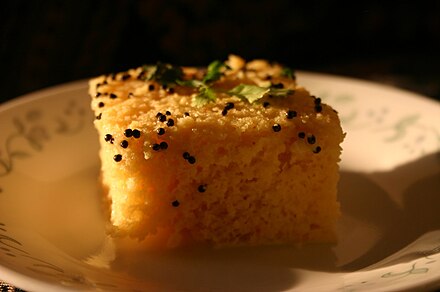
-
Asarfi Kulfi (Area: Panchwati & Law Garden & Gurukul) They only serve dessert. Try any of the Kulfis
-
Bhagwati Chat (Area: Panchwati) The best dish is the paneer tikka. Try the gulab jamun or jabeli for dessert.
-
Oswal (Area: Ashram Road Nr. Statue of Mahatma Gandhi) Snack shop specialising in Gujarati snacks and sweets such as Jalebis (sweet-syrup filled pretzels), Fafda (flat chick-pea biscuits served with spicy papaya chutney).
-
Raipur Bhajia House (Area: Raipur Darwaja) Famous for Bhajias (much better taste & quality than the Astodia Bhajia)
-
Cafe Upper Crust (Area: Vijay Char Rasta, Vastrapur) A popular cafe with teenagers. Dishes including veg/non-vegetarian sizzlers, pastas, sandwiches, cakes and desserts. Hosts occasional food festivals.
-
Mirch Masala (Area: CG Road, SG Road) Serves North-Indian food in a typical highway "dhaba" setting. Excellent food but more interesting for its decor.
-
King's Food Factory (Area: Panchwati cross road, CG Road) It is new restaurant chain. They serve Indian cuisine as well as some Spanish, Italian, Chinese and American food. Very nice dessert are available in the coffee parlour and there is a possibility to play some scrabble or uno upstairs. It is clean, all staff speak English; Wi-Fi, A/C and two plasma TV screens.
-
ZK(Area: Relief Road). One of the best and oldest non-veg restaurant in the city
-
Ras Ranjan (Area: Vijay Char Rasta). Great place for sweets, Bislari Paani Puri, Paneer Tikka w/famous chutney, vaada pav.
-
Pudding Good veg and non-veg food, and in particular the Hydrabadi Biryani.
-
Seva Cafe is a gift economy restaurant, serving meals made by volunteers. The meals are offered as gifts to the guests who are asked to ‘Pay Forward’ as a chain of kindness. The guests and volunteers have continued this chain have provided more than 85,000 meals.
Other than these that are several other restaurants that serve excellent food for example (Swati Snacks, House of MG both famous for Gujarati food in chic setting, Bawarchi for Punjabi food, etc.) For western palates, a good way to find new restaurants is to ask a local, especially someone young who would certainly know about such places. International chains like Pizza Hut, McDonalds, Subway are present throughout the city.
For some street food following places are quite famous:
- R. K. Vadapau, Vijay Char Rasta, Vada Pau at its best, it is also known as Anna's Vada Pau
- Karnavati Dabeli, Opp. Hirabhai Tower, Uttam Nagar, Maninagar, Best Kachhi Dabeli
Drink
Gujarat is one of the few Indian states where alcohol is prohibited. But this applies only to Indians. If you have a non-Indian passport / green card holder/ PR status, you can get an alcohol permit valid for one month by going to an alcohol shop in a large hotel and purchasing one. Hotels that have alcohol shops include: Cama Hotel in Khanpur, Hotel Inder Residency, Opp. to Gujarat College, Comfort Inn President Hotel at CG Road among others open Monday to Saturday noon-8PM, ph no. +91 79 26467575. Many local people will be able to direct you because they can purchase alcohol on a 'health' licence. If you are non-resident of Gujarat, then one can get alcohol permits issued at alcohol shops on showing proof of travel to Ahmedabad like (1) Air/Train/Bus ticket,(2) any Identity proof by Govt. with Photo, Address & birthdate preferably driving licence and (3a) your Ahmedabad address proof such as Residence Address of Local friend/relatives electric/telephone bill/ driving licence or (3b) Proof of stay at hotel.
However, if you are staying longer you will need a non-resident permit. For that, you will need: a photocopy of passport including your entry stamps, a photocopy of visa, a photocopy of a local resident's ID card (drivers licence will probably be easiest). As of January 2009, ₹1000 (although the person may ask for ₹50 extra as a bribe but should not be given). If you can get a local person to go with you, the entire experience will be a lot easier.
Directions 1 Get your copies notarized as ‘true’ copies. If you don't have easy access to someone who can do this, the Prohibition and Excise Department will direct you to a nearby office. This will cost about ₹10 per copy. 2. Go to Prohibition and Excise Department which is just off the Ellis bridge on the Victoria garden side of old city . 3. Pick up the bank payment form, and get copies notarized if you haven't already done this. 4. Fill in the name and local address for the permit holder 5. Get a rickshaw and go to the State Bank of India which is very near by. If a rickshaw is not available, the bank is in walking distance. 6. Pay ₹1050 (or the asked fee) at the State Bank of India 7. Get an ink stamp on form from bank 8. Take your copies, your payment slip and your forms back to the Prohibition and Excise Department. 9. The Department office will provide you with form F.L. /A-1. Fill out form and ask for more than the maximum allowed (ask for about 6 units) to ensure you get the maximum. 10. Pay ₹2 at the Department office. Receive two stamps which are to be stuck onto get form F.L. / A-1 form to show you have paid.
You will either be able to pick up the license immediately, or in a few days. Once you have your licence, you take it to a large hotel where they have an alcohol shop, and make your purchases.
Bootlegging is rampant, but it carries a risk as well. Decent brands of Indian whisky start around ₹200 as do rum, vodka and gin. Premium brands range from ₹600 to ₹1,800 for 12-year-old Scotch. It is difficult to find beer, wine, champagne and imported spirits.
Booze is strictly a private affair and don't expect to order a drink at a restaurant, and there are no pubs or bars, and you will have to drink in your hotel room or at someone's home. If someone invites you to a party, there is a good chance you will be offered a drink there. Under a new amendment to the law prohibiting alcohol, you cannot be arrested or detained for consuming alcohol illegally unless you misbehave under influence or are bootlegging. However, it is best to consume alcohol at your hotel room or at a very close friends place. Consumption of alcohol in hotel rooms has implied consent from the hotel who will serve you ice, glasses and mixers.
Many small shops sell lassi, a yogurt drink. Lassi choices include: sweet, salty, with almonds. Farki, Girish Cold Drinks and Krishna Dairy are some of the famous ones. Apart from this, Janta Ice Cream and Cold Drinks offers a delicious drink cold Chocolate Coco, a chocolate flavoured thick shake. Janta has its shops across Ahmedabad. There is also a very wide variety of fruit juices available. Most large places like Havmor are reputable and use good water, but you should exercise care when drinking at smaller places.
Sleep
Budget
Cheaper hotels are available on the Eastern side of the Sabarmati in the old town area.
More expensive and newer hotels are available in the more affluent Navrangpura area.
In case you don't have an idea where to go when you arrive to the city, you could ask a rickshaw driver to take you to Relief Road which has plenty of budget accommodation available and is pretty close to the main train station.
- Ginger Hotel. Off Drive-in road, close to the SG Road Business district. A no-frills, business class hotel, similar to the other Gingers. From ₹1000/night.
- Hotel Caspia Pro, Plot 38/1, Prahladnagar Road, Besides Venus Atlantis, Prahlad Nagar, +91 79 4900 4141. The chain opened in July 2012.
Mid-range
- Lemon Tree Hotel, Ahmedabad in Ahmedabad's downtown shopping and commercial area of CG Road in Navrangpura, this is an attractive and airy hotel.
- Hotel Royal Highness is in the heart of business and shopping areas at Lal Darwaja. This hotel charges a premium mid range hotel tariff, with around 50 rooms and 8 conference rooms.
- Hotel Cama Park Plaza is a landmark of culture and comfort in the city of Ahmedabad. It is in the heart of business and shopping areas. It combines old-world charm with 21st century amenities.
- Hotel Comfort Inn Sunset has a unique architectural design. Its close proximity from Airport is another advantage.
- Hotel Fortune is an economy hotel of Ahmedabad around 10 km from the Airport. Ammeneties include large meeting rooms, business facilities and food & beverage options. Close to the city centre, government houses and major business center in the city.
- Hotel Comfort Inn President, on C.G. Road, sells a wide range of brands of whisky, wine and beer. Liquor permits issued in the liquor shop to non-residents of Gujarat and foreigners against photo ID.
- Hotel Quality Inn is a business class hotel in the commercial district on the banks of Sabarmati River. Hotel provides an excellent view of the river at dawn and in the evening. Has 69 rooms & suites, multi-cuisine restaurant, health club and business centre.
- Hotel Westend is in the commercial area.
- Hotel Country Inn is a hotel suited for business travellers in the business and shopping areas, off Drive-In Road.
- Hotel Ramada is suited for business travellers in Prahladnagar, near the SG Road, which is a business and shopping area
Splurge
- Hyatt Ahmedabad. In city centre adjacent to the Vastrapur Lake.
- Gateway Hotel (formerly Taj Residency). Close to the airport and 15-minute drive from the central business district and state capital, Gandhinagar.
- Hotel Le Meridien. From ₹3750/night
- Hotel Pride is in the Judge's Bungalows area by Sarkhej-Gandhinagar Highway.
- Hotel Fortune Landmark on Ashram Road.
- Hotel Inder Residency is in calm and quiet western suburbs of Ahmedabad close to main commercial roads: C.G & Ashram road. Easy accessibility to the Railway Station and Airport.
- Hotel Courtyard by Marriott. On Satellite Road.
- Royal Orchid Central, +91 80 4127 6667. Near Gujarat College.
- House of MG - in the old historic city is a 5-star Heritage Hotel
- The Grand Bhagwati, 301, Circle P, Prahaladnagar Garden Road, S.G. Road, +91 7926841000, infoahmd@tgbhotels.com. Bodakdev, SG Road
- Cambay Grand - Thaltej, Sarkhej-Gandhinagar Highway
- Hotel St Laurn is in the city centre, Ashram Road
Connect
International code for India is +91 The local area code is 79. Thus in total, +91 79 must be prefixed to a phone number.
Buy pre-paid SIM
To buy a SIM card foreign nationals need to provide a photocopy of their passport, Indian visa page, a passport-sized photo and a proof of residence in India. As with much in India, the associated bureaucracy can be slow and frustrated. Activation of a SIM card can take a number of days.
The top mobile phone networks in India are:
- Bharti Airtel, Bharti House, Nr. Income Tax Office, Ashram Road, +91 20 44448080, 121@in.airtel.com. Very good connectivity and service. Although the main office is at Ashram Road as listed, there are several shops where you can buy SIM.
- Vodafone Idea, Vodafone West Limited, 6th floor, Sakar - II, Ellisbridge, Ahmedabad - 380006, +91 79 26577228, nodal.guj@vodafone.com. Among the best networks in India.
- Bharti Sanchar Nigam Limited (BSNL), BSNL Central Exchange Office, Mirzapur, Shahpur, Ahmedabad. The state - owned cellular network.
- Jio.
Emergency information
- Emergency Help (at any time) - 108
- Police - 100
- Fire - 101
- Ambulance - 102 / 108
- Airport Inquiry - 141
- Railways I.V.R.S. - 139
- Railways General Enquiry - 131
- Telephone Directory Inquiry - 197
- Telephone Local Assistance - 199
Cope
The railway reservation office, and tourist booking window, are in an air conditioned building just outside and to the right (when looking from the street) of the Kalupur Railway station. Other railways stations are able to book tourist quota, but often refuse to serve you and refer you to Kalupur Railway station after a lengthy wait.
- Canada and United States Visa Facilitation Centre Gujarat Chambers Building, Shri Ambika Mills, Ashram Road (Ellis Bridge)
Hospitals
For medical emergencies, dial 108.
- Civil Hospital (General Hospital), Ahmedabad Civil Hospital, Asarwa, 23.051°, 72.604°, +91 79 22683721, ms.health.ahmedabad.civil@gmail.com. It is Asia's largest hospital. One of the oldest and most modern hospitals in India.
The main Apollo Hospital is in the twin city of Gandhinagar, but very close to the airport. The Apollo City Centre is in Ellisbridge area (West Zone).
- Apollo Hospital (Main) (Near Airport), Plot No.1 A, Bhat GIDC Estate, Gandhinagar, +91 79 66701800, info@apolloahd.com.
- Apollo Hospital City Center (Ellisbridge), 1, Tulsibaug Society, Opp. Doctor House, Nr. Parimal Garden, Ellisbridge, +91 79 66305800, info_ahcc@apolloahd.com.
- Shalby Hospital (Main) (S G Highway), Opp. Karnavati Club, S G Highway, +91 79 40203000, info@shalby.org.
- Shalby Hospital (City Center Unit) (Navrangpura), Vijay Cross Road, Nr. Fire Station, Navrangpura, +91 79 27910700, info@shalby.org.
- Krishna Shalby Hospital (Ghuma), 319 - Green City, Ghuma, Via Bopal, +91 2717 230877, info@krishnaheart.org.
- Krishna Shalby Hospital (Maninagar), Siddhi Vinayak Complex, Balvatika - Maninagar Road, Kankaria, Maninagar, +91 9724355522, info@krishnaheart.org.
- Care Institute Of Medical Sciences (CIMS), CIMS Hospital, Nr. Shukan Mall, Off Science City Road, Sola, +91 79 27712771. CIMS Hospital is accredited by various national bodies.
- Sterling Hospital, Sterling Addlife India Limited, Sterling Hospital Road, Memnagar, +91 79 40011111, info@sterlinghospitals.com. Has a range of specialities. 2018-01-01
- Sanjivani Hospital, Sanjivani Super Speciality Hospitals Pvt. Ltd, 1, Uday Park Society, Nr. Sunrise Park, Vastrapur, +91 79 26306341, vgb.sanjivani@gmail.com. A multi-speciality hospital founded in 1987.
- Retina Foundation and Eye Research Centre (Dr Nagpal's), Retina Foundation and Eye Research Centre, AsoPalov Eye Hospital, Near the Underbridge, Old Raj Bhavan Road, Shahibaug, +91 79 22865537, myeyes@retinafoundation.com. One of the most renowned eye care hospitals in India. 2018-01-01
- Radiance Hospitals, Shital Varsha Mall, Drive In Rd, Memnagar, +91 70432 11118, radiancehospitals@gmail.com.
News
Stay updated with local news.
- Newspapers in Ahmedabad include Hindi dailies as Herald Young Leader, Metro Herald, and English dailies such as The Times of India (TOI), The Indian Express, Daily News & Analysis (DNA), The Economic Times and The Financial Express, Ahmedabad Mirror (AM). Newspapers in other languages (Gujarati and Hindi) include Divya Bhaskar, Akila Gujarati News, Gujarat Samachar, Sandesh,Sukan Samachar (dead link: January 2023), Rajasthan Patrika (dead link: January 2023), Sambhaav Metro and Aankhodekhi.
- The state-owned All India Radio Ahmedabad is broadcast both on the medium wave and FM bands (96.7 MHz) in the city. It competes with five private local FM stations: Radio City 91.1 (91.1 MHz), Red FM 93.5 (93.5 MHz), 94.3 My FM (94.3 MHz), Radio One (95.0 MHz), Radio Mirchi 98.3 (98.3 MHz). Gyan Vani (104.5 MHz) is an educational FM radio station run under media co-operation model.
Stay safe
People are friendly and the police will help you when you have an emergency. Ahmedabad is relatively safe because alcohol is not permitted: no late-night rowdyism as seen in other cities.
Police stations
Ahmedabad City Police has around 35 major police stations besides the minor police chowkis.
For emergency, dial 100.
Find your police station (dead link: January 2023) depending on the area. Contact details (e-mail IDs and phone numbers) can be found when clicking on the respective station.
Go next
- Akshardham temple in Gandhinagar - a 35 km ride from Ahmedabad is not to be missed. They have various shows throughout the day showing the rich Indian heritage and the legend of Lord Swaminarayan. The water show in the evening is one of the best you will find in India.

- Adalaj Step-Well - a remarkable structure, dug five stories deep underground and full of intricate carvings. 15 km north of Ahmedabad. See Gandhinagar article for details.
- Nal Sarovar - Bird Sanctuary About 65 km southwest of Ahmedabad, spread over 120 km<sup>2</sup>, the lake - Nal Sarovar - the extensive reed beds and marshes are an ideal habitat for aquatic plants and animals. The lake attracts a large variety of birds like plovers, sandpipers, stints, cormorants, grebes and openbill storks among others. The best season to visit the sanctuary is November to February.
- Thol Bird Sanctuary This sanctuary is about 30 km west of the city centre. Just as Nal Sarovar, this lake attracts a large variety of bird species. It has become more preferable for the amdavadis to take an early morning trip. Although it does not have any facilities like boating, it has turned out more favourable as this is a lesser known place. It will be best to rent a taxi for a morning as there is no public transport available here. November to March is the best time to visit.
Ahmedabad
ahmedabadcity.gov.inAhmadābād
2nd-order administrative division
Gujarat
Primary administrative division


